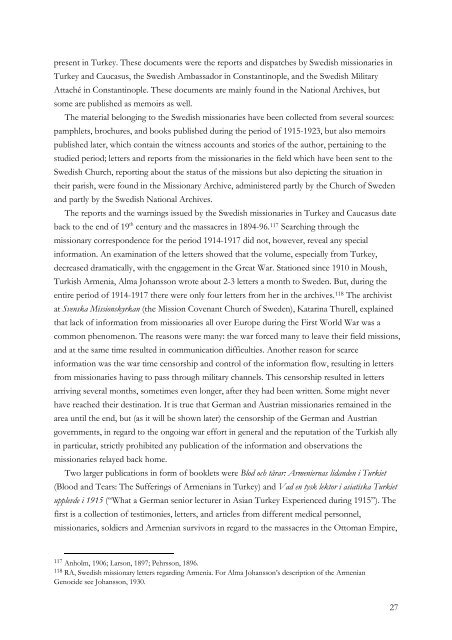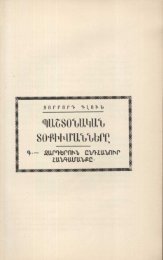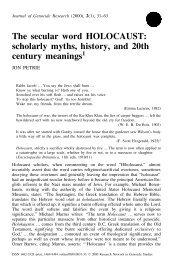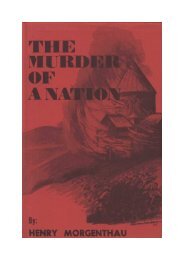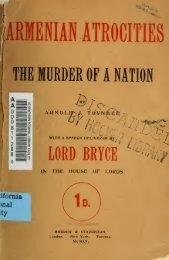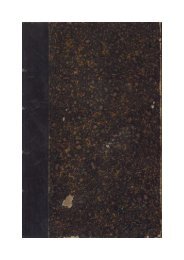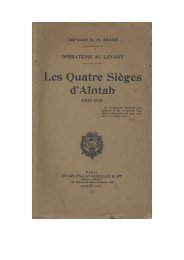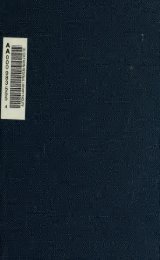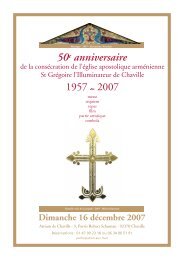improper conduct could jeopardise the trade relations with the offended nation for years to c<strong>om</strong>e,thereby damaging Sweden’s econ<strong>om</strong>ic life. 115 But despite the obvious cautiously Germanamiability and overall neutrality, the Swedish newspapers did mention the Armenian massacres,both in articles fr<strong>om</strong> foreign news agencies, and in debate articles written by d<strong>om</strong>estic politiciansand other persons. This approach will also be traced in the behaviour of the future SwedishAmbassador to Turkey influencing Sweden’s policy making.The Germanophile attitude had an obvious impact – that of cautiousness in criticisingGermany and German allies, e.g. Turkey. The Ott<strong>om</strong>an Government joined the German-Austrian side in the fall of 1914. Therefore, as long as Turkey was fighting the Entente, allTurkish actions were by Germany de facto regarded as justified and thus not criticised – neitherin Germany nor in German friendly countries. As it will be shown, Sweden, belonging to thelatter group, adhered to this policy.The telegrams, bulletins, feature articles, editorials and news articles were collected fr<strong>om</strong>respective newspaper, archived through the microfilm depository at Carolina University Libraryin Uppsala. For this purpose s<strong>om</strong>e of the major newspapers of the time were studied during theperiod of 1915-1923. Using the diversity of the material studied in Längtan till Ararat, thenewspapers included in the material were Social-Demokraten (SD), Dagens Nyheter (DN), SvenskaMorgonbladet (SvM), Svenska Dagbladet (SvD), and Nya Dagligt Allehanda (NDA). The choice ofthese newspapers was done due to the fact that they were s<strong>om</strong>e of the major organs for thedifferent camps engaged in the war. SD and DN were overall Entente-friendly, while the twolatter were regarded as conservative and German-friendly, while SM was a Liberal Free Churchnewspaper. NDA’s German affiliation would blo<strong>om</strong> into full sympathy for National-Socialismduring the 1930s. 116 The spread of the ideology and affiliation with different camps in the war areadequately represented by these newspapers for rendering a representative view of the coverageof the Armenian massacres.For finding relevant information during the investigated period, the mentioned papers weresearched for articles mentioning the Armenian massacres and, later, the question of the ArmenianRepublic. These could both be articles confir<strong>min</strong>g the news about massacres or denying theirexistence. Both kinds of articles have been taken into consideration for rendering the wholepicture presented to the Swedish readers and to see how and if the papers initiated any attemptsat influencing public opinion building about Swedish Governmental intervention or civilorganised humanitarian assistance for the Armenian victims.1.4.3 Swedish Christian Mission and other Field Mission ReportsWhile the information published by the newspapers were “second-hand intelligence”, acquiredfr<strong>om</strong> foreign news agencies, there are more reliable information, documented by individuals115 Lundström, Rydén, and Sandlund, 2001, p. 125.116 Lundström, Rydén, and Sandlund, 2001, p. 258; Sturve, Sunnerstam, and Sönnergren, 1985, p. 215.26
present in Turkey. These documents were the reports and dispatches by Swedish missionaries inTurkey and Caucasus, the Swedish Ambassador in Constantinople, and the Swedish MilitaryAttaché in Constantinople. These documents are mainly found in the National Archives, buts<strong>om</strong>e are published as memoirs as well.The material belonging to the Swedish missionaries have been collected fr<strong>om</strong> several sources:pamphlets, brochures, and books published during the period of 1915-1923, but also memoirspublished later, which contain the witness accounts and stories of the author, pertaining to thestudied period; letters and reports fr<strong>om</strong> the missionaries in the field which have been sent to theSwedish Church, reporting about the status of the missions but also depicting the situation intheir parish, were found in the Missionary Archive, ad<strong>min</strong>istered partly by the Church of Swedenand partly by the Swedish National Archives.The reports and the warnings issued by the Swedish missionaries in Turkey and Caucasus dateback to the end of 19 th century and the massacres in 1894-96. 117 Searching through themissionary correspondence for the period 1914-1917 did not, however, reveal any specialinformation. An exa<strong>min</strong>ation of the letters showed that the volume, especially fr<strong>om</strong> Turkey,decreased dramatically, with the engagement in the Great War. Stationed since 1910 in Moush,Turkish Armenia, Alma Johansson wrote about 2-3 letters a month to Sweden. But, during theentire period of 1914-1917 there were only four letters fr<strong>om</strong> her in the archives. 118 The archivistat Svenska Missionskyr<strong>kan</strong> (the Mission Covenant Church of Sweden), Katarina Thurell, explainedthat lack of information fr<strong>om</strong> missionaries all over Europe during the First World War was ac<strong>om</strong>mon phen<strong>om</strong>enon. The reasons were many: the war forced many to leave their field missions,and at the same time resulted in c<strong>om</strong>munication difficulties. Another reason for scarceinformation was the war time censorship and control of the information flow, resulting in lettersfr<strong>om</strong> missionaries having to pass through military channels. This censorship resulted in lettersarriving several months, s<strong>om</strong>etimes even longer, after they had been written. S<strong>om</strong>e might neverhave reached their destination. It is true that German and Austrian missionaries remained in thearea until the end, but (as it will be shown later) the censorship of the German and Austriangovernments, in regard to the ongoing war effort in general and the reputation of the Turkish allyin particular, strictly prohibited any publication of the information and observations themissionaries relayed back h<strong>om</strong>e.Two larger publications in form of booklets were Blod och tårar: Armeniernas lidanden i Turkiet(Blood and Tears: The Sufferings of Armenians in Turkey) and Vad en tysk lektor i asiatiska Turkietupplevde i 1915 (“What a German senior lecturer in Asian Turkey Experienced during 1915”). Thefirst is a collection of testimonies, letters, and articles fr<strong>om</strong> different medical personnel,missionaries, soldiers and Armenian survivors in regard to the massacres in the Ott<strong>om</strong>an Empire,117 Anholm, 1906; Larson, 1897; Pehrsson, 1896.118 RA, Swedish missionary letters regarding Armenia. For Alma Johansson’s description of the ArmenianGenocide see Johansson, 1930.27
- Page 3 and 4: 1 Introduction.....................
- Page 5 and 6: War, rather confirm the version of
- Page 7 and 8: 1.2 Previous ResearchWhen discussin
- Page 9 and 10: Military Attaché and the missionar
- Page 11 and 12: situation: “It is a crime when Te
- Page 13 and 14: in the following investigation, whi
- Page 15 and 16: killed. The slaughterer slaughtered
- Page 17 and 18: interests. Despite his famous “14
- Page 19 and 20: morality, balance of power, or the
- Page 21 and 22: 4. International organisations (e.g
- Page 23 and 24: warring parties. 104 This observati
- Page 25: Concerning the protocols of the Swe
- Page 29 and 30: He also mentions meeting an Armenia
- Page 31 and 32: the annihilation. General von Losso
- Page 33 and 34: 1.5 BackgroundIn order to understan
- Page 35 and 36: 1914, when two inspector-generals f
- Page 37 and 38: to Islam or were sold as slaves to
- Page 39 and 40: 2 Empirical AnalysisThe empirical r
- Page 41 and 42: It does not seem to be the Turkish
- Page 43 and 44: The Turks claim that, at the Russia
- Page 45 and 46: The Armenian population has equippe
- Page 47 and 48: 1917 was the revival year for the A
- Page 49 and 50: Even if the communication between t
- Page 51 and 52: implemented against the Armenian na
- Page 53 and 54: Anckarsvärd continued claiming tha
- Page 55 and 56: Germany is blamed for its accessory
- Page 57 and 58: Here Wirsén took the liberty to co
- Page 59 and 60: On February 19, news of new Armenia
- Page 61 and 62: estricted to the fields of intrigue
- Page 63 and 64: generous offer of President Wilson
- Page 65 and 66: Lange gave a detailed description o
- Page 67 and 68: skin was totally scorched. Another
- Page 69 and 70: which her recurrently emphasised th
- Page 71 and 72: The sooner calls referring to the A
- Page 73 and 74: Despite these facts, Armenia was th
- Page 75 and 76: Svenska Riksarkivet [Swedish Nation
- Page 77 and 78:
Bakhtiari, Kalla det vad fan du vil
- Page 79 and 80:
Chan, Steve and Drury, Cooper A., S
- Page 81 and 82:
Moranian, Suzanne Elizabeth, Bearin


